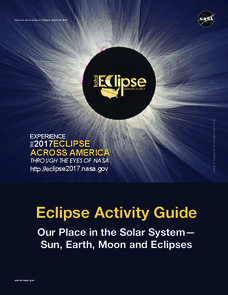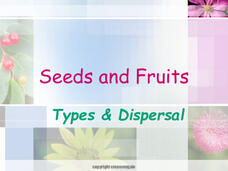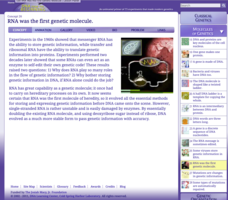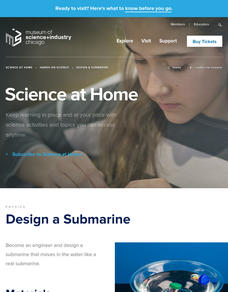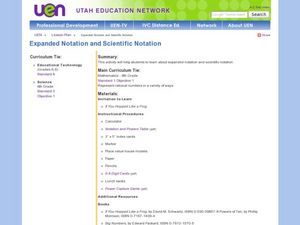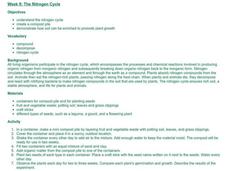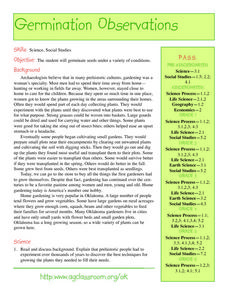Chicago Botanic Garden
Recognizing Change (Observation vs. Inference)
What is the difference between making inferences and making observations? Young climatologists refer to a PowerPoint to make observations on each slide. They record their observations in a provided worksheet before drawing a...
Science Matters
Spaghetti Fault Model
Does increasing the pressure between two moving plates provide a stabilizing force or create more destruction? The hands-on lesson encourages exploration of strike-split fault models. The sixth lesson in a 20-part series asks scholars to...
NASA
Eclipse Activity Guide
Ever made solar s'mores? Or recreated the solar system using peanuts? Astronomers young and old investigate all things solar using a variety of activities. Explore how the sun works, types of light it emits, and methods of charting the...
NOAA
Wet Maps
How do oceanographers make maps under water? Junior explorers discover the technologies and processes involved in creating bathymetric maps in part three of a five-part series designed for fifth- and sixth-grade pupils. The lesson...
Physics Classroom
Name That Energy
Many upper level tests require pupils to interpret written descriptions of scientific principles. Scholars practice the skill by working through three levels of difficulty. Each question covers kinetic energy, gravitational potential...
Biology Junction
Seeds and Fruits: Types and Dispersal
Did you know that some seeds rely on elephant dung for dispersal? Pupils use class discussion and direct instruction based around a presentation to learn about seed types and dispersal methods. Slides vary from presenting content to...
Cold Spring Harbor Laboratory
RNA Was the First Genetic Molecule
Can organic molecules come from a pre-biotic environment? Stanley Lloyd Miller proved it is possible when exactly the right conditions exist. Learn about his experiment and the other experiments later building off of it that changed the...
New York City Department of Education
Straw Rockets
Scholars become rocket scientists as they take off on a journey exploring Newton's laws of motion. After learning the laws of motion, pupils design their own investigations using straw rockets. They highlight their literacy skills in a...
Museum of Science
Design a Submarine
Don't just sink the boat. Using a closed container as a submarine, pupils experiment to see what to add to the container to make it float, sink to the bottom, and hover in the middle. After finding one option, learners see if they can...
American Chemical Society
Exploring Baking Powder
Birthday cake wouldn't be light and fluffy without the chemical reactions between ingredients. Young scientists explore some chemical reactions in the 11th installment of a 16 lesson Inquiry in Action series. They determine the...
American Chemical Society
Identifying an Unknown Liquid
Liquids are what's the matter with the lesson! Learners investigate properties of different liquids as they interact with various types of paper. They then use their observations to identify a mystery liquid to finish the sixth lesson in...
American Museum of Natural History
Rubber Blubber Gloves
Using gloves, shortening, tape, and a lot of ice, participants experience the feeling of having blubber. The experiment's eight steps follow an informative page about blubber and animals that have it.
Curated OER
Represent Rational Numbers
Students identify expanded notation and scientific notation. In this rational numbers lesson, students use a calculator to discover the powers of 10. Students practice writing numbers in expanded notation using powers of 10. Students...
Curated OER
The effectiveness of Antacids
Students design and conduct a scientific experiment to test which of four antacids would be most effective for neutralizing acids. They rank the antacids in order from most effective to least effective and explain how they determined...
Curated OER
20th-Century Astronomy
Pupils examine and explain how the distance to nearby stars can be measured by the parallax method, discuss the role of women in the history of American astronomy, form their own opinions of the importance of Harlow Shapley and Edwin...
Curated OER
Questions About Rivers
Students investigate rivers. In this geography lesson, students work in cooperative groups to read about rivers from articles they have collected. Students form questions using Bloom's Taxonomy as a guide.
Curated OER
Soap Smart, Healthy Fun
Seventh graders investigate the scientific methods of testing the effectiveness of soap use against germs. They study the history and chemistry of soap as it has helped control the spread of germs. They make bubble soap.
Curated OER
The Nitrogen Cycle
Students design and create a compost pile in order to study the Nitrogen Cycle. They then use the scientific method to determine if plants grow better when they add organic matter from their compost pile to the plant's soil.
Curated OER
Germination Observations
Students germinate seeds under a variety of conditions. First, students read and discuss the background of gardening. After reviewing germination and the steps to the scientific method, groups of students complete experiments.
Curated OER
Topic: Science Fair Project
Young scholars brainstorm ideas for science fair projects. Students observe a PowerPoint presentation and explore the scientific method. In groups, they formulate a hypothesis. Using the internet, young scholars research their topic...
Curated OER
Snow Goggles And Limiting Sunlight
Students investigate the effects of light radiation on the human eyes. They construct a pair of snow goggles that are used to see how a filter can protect the eyes from radiation. Then students explain how the scientific method can be...
Curated OER
Matching Flowers With Their Pollinators
Students match flowers to pollinators and construct models of
flowers to demonstrate why different kinds of flowers need different kinds of
pollinators. They use their flower models and the "Scientific Method Format" included in the...
Curated OER
Bubbles
Young scholars experiment bubbles. In this scientific method lesson, students identify variables used in proper experiment design. Young scholars conduct experiments with different brands of dish-washing detergent to determine which...
Curated OER
Exploring Motion
Sixth graders study a wind up toy and marble set-up. In this physics lesson, 6th graders work through the steps of the scientific method as they make observations about motion and inertia.




